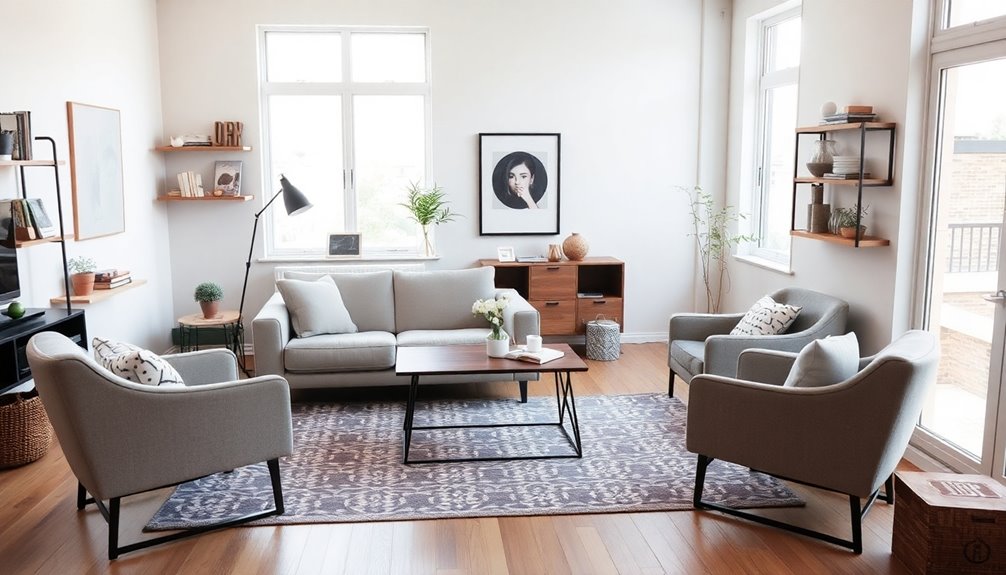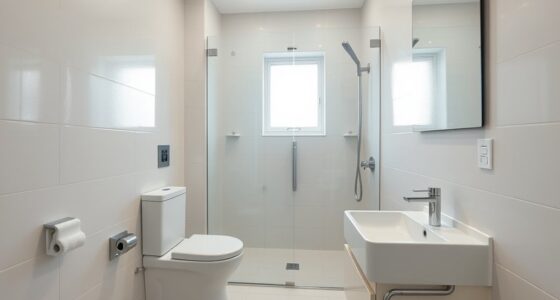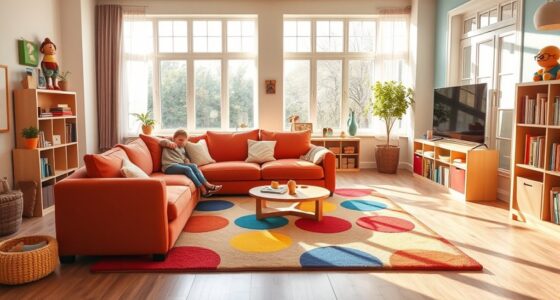To make the most of small spaces, focus on creating a focal point, like a TV or artwork, and arrange your furniture around it. Pull seating away from walls to encourage conversation. Opt for light-colored, multi-functional pieces to avoid a cramped feel. Maximize vertical space with tall shelving and make the most of natural light. Using area rugs can help define different zones in open layouts. There's plenty more to explore on optimizing your space efficiently.
Key Takeaways
- Utilize area rugs to define distinct zones for various activities, creating visual boundaries in small spaces.
- Position furniture away from walls to foster cozy conversation areas and promote better flow within the room.
- Choose multi-functional furniture pieces to maximize space while maintaining functionality and visual lightness.
- Incorporate vertical elements like tall shelving and wall-mounted storage to draw the eye upward and create an illusion of spaciousness.
- Select light-colored or neutral furnishings to enhance openness and keep the atmosphere inviting and airy.
Incorporate a Focal Point
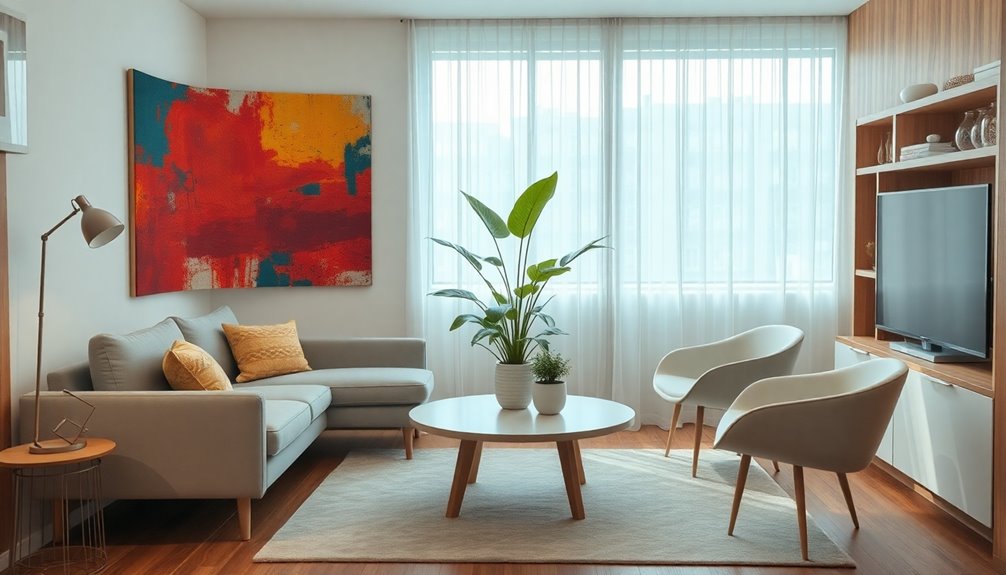
When designing a small space, incorporating a focal point is essential, as it gives the room a sense of purpose and direction.
A well-defined focal point, like a TV or fireplace, serves as the centerpiece around which your furniture placement should revolve. Positioning your seating to face or surround this focal point enhances visual interest and creates a cozy conversation area.
Keeping clear views of the focal point avoids obstructions and maintains an open space, making your small living room feel inviting. Aligning your furniture with the focal point fosters a cohesive layout, enhancing the overall room feel.
Plus, consider using additional seating that complements this arrangement, further enhancing the aesthetic and functionality of your space.
Space-Defining Layout
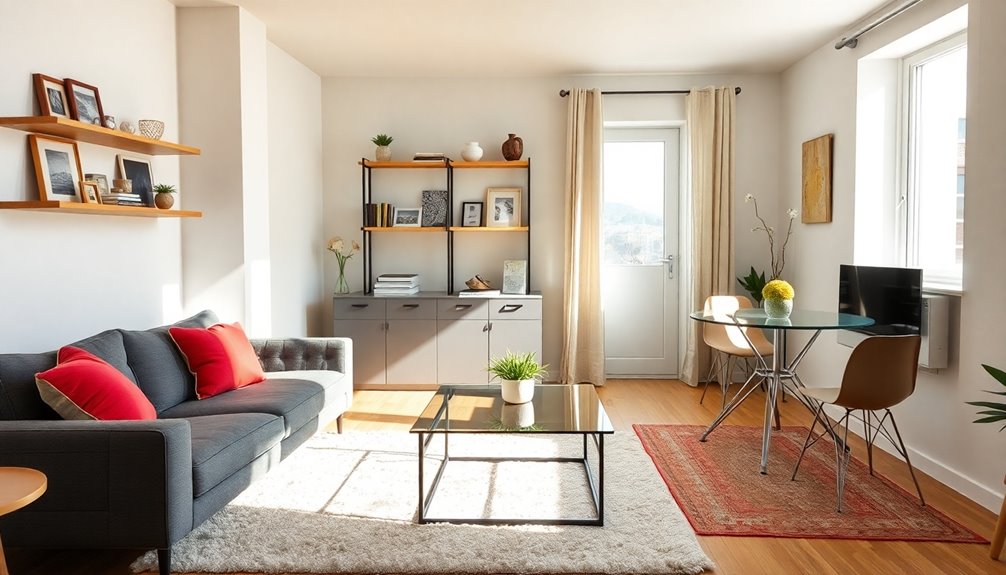
Creating a space-defining layout can transform your small area into a functional and inviting environment. Position your sofa with its back facing the dining area to create a visual boundary, effectively defining the living space. This furniture arrangement not only enhances the aesthetic but also promotes a cozy atmosphere.
Use rugs to visually differentiate zones, establishing distinct areas within your open-concept layout. Incorporating accent furniture, like side tables and chairs, reinforces separation without obstructing flow.
Remember to maintain clear pathways in the living area for easy movement and accessibility. By thoughtfully arranging your seating and using rugs, you'll create a harmonious layout that invites comfort and purpose into your small space.
Pull Furniture Away From Walls
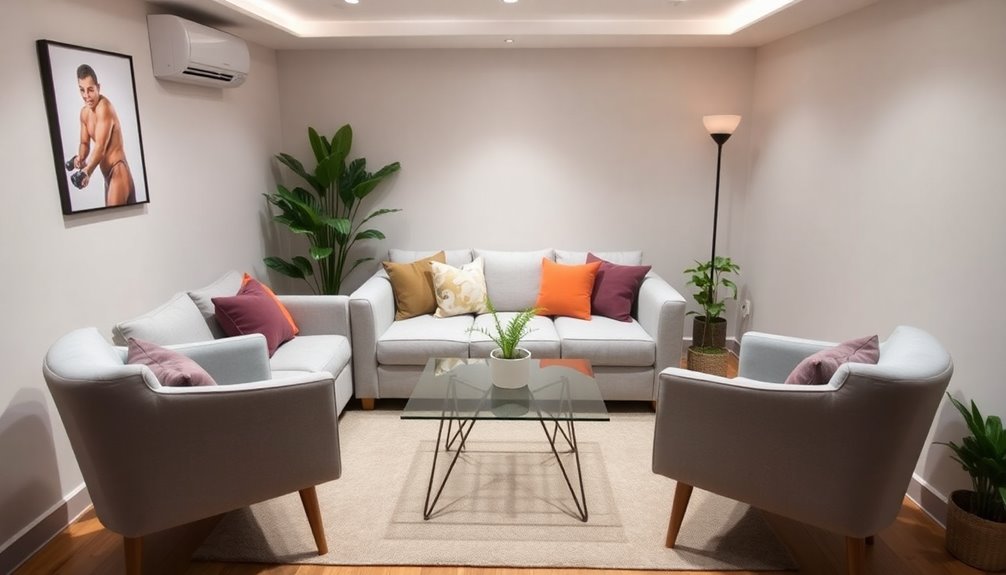
To further enhance your small space, consider pulling furniture away from the walls. This simple shift creates a cozy conversation area, encouraging closer interactions and enhancing warmth throughout the room. A central seating arrangement allows for better flow, making the room feel larger and more inviting. By utilizing the central space, you can foster intimacy and connection, which is key in small spaces. Plus, positioning furniture away from walls helps create defined zones, adding functionality and aesthetic appeal to your furniture layout. Additionally, this layout can mirror the open floor plans commonly found in modern farmhouse designs, promoting a welcoming atmosphere.
| Benefits | Description |
|---|---|
| Cozy Conversation Area | Encourages closer interactions |
| Enhanced Room Feel | Makes the room feel larger and more inviting |
| Utilized Central Space | Promotes better flow and movement |
| Defined Zones | Increases functionality and organization |
| Enhanced Warmth | Adds a welcoming atmosphere |
Use Light Visual Weight Furnishings
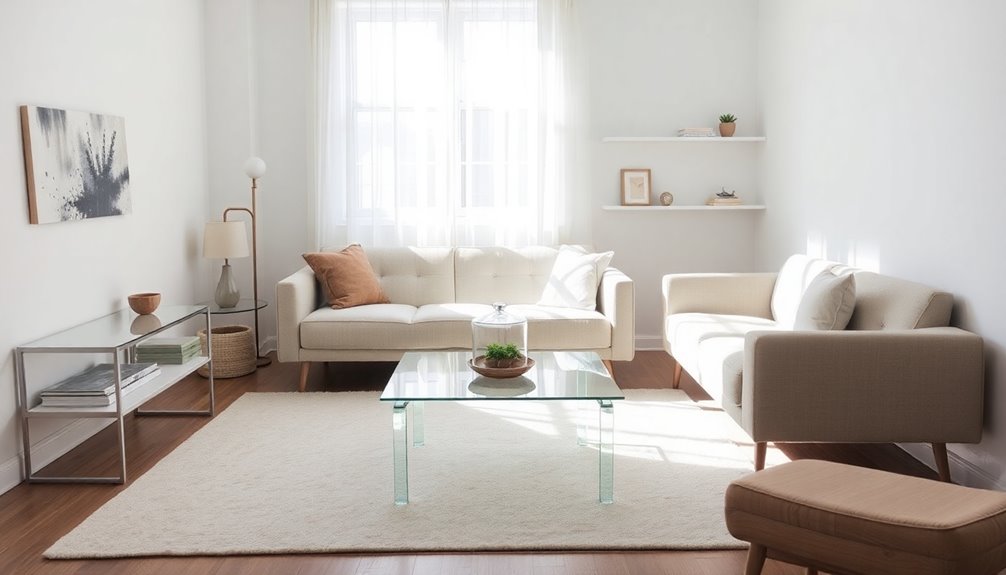
When you're furnishing a small space, choosing light-colored pieces can make a world of difference.
Light hues create an airy feel, helping the area appear larger and more open.
Choose Light-Colored Pieces
Light-colored furniture can transform a cramped space into an airy oasis. By incorporating light colors, you create the illusion of spaciousness, making small spaces feel more open.
Choose sofas and chairs with legs to enhance visual openness, allowing more floor space to show. Opt for small, light coffee tables and accent pieces to maintain flow without overwhelming the room.
Light-toned upholstery, like linen or light cotton, fosters an inviting atmosphere, perfect for cozy gatherings.
Consider multi-functional furniture, such as ottomans that serve as storage or extra seating, to balance functionality with visual lightness.
With these choices, your small space will feel bright, welcoming, and effortlessly stylish.
Emphasize Open Space
Creating an open space in your small room can greatly enhance its overall feel. To achieve this, focus on using light-colored furniture, such as whites or pastels, which can create the illusion of more space.
Choose small visually light coffee tables that won't dominate the area, allowing for better flow in your open floor plan. Opt for slim and minimalist designs like narrow tables and sleek armchairs to maximize functionality without overwhelming your visual space.
Additionally, incorporating furniture pieces with legs improves floor visibility, contributing to an airy atmosphere. Utilizing effective wall organization can also help maintain a tidy and open environment, further enhancing the feeling of spaciousness.
Finally, area rugs can define spaces without closing them off, helping you make your living room feel both inviting and expansive.
Maximize Vertical Space
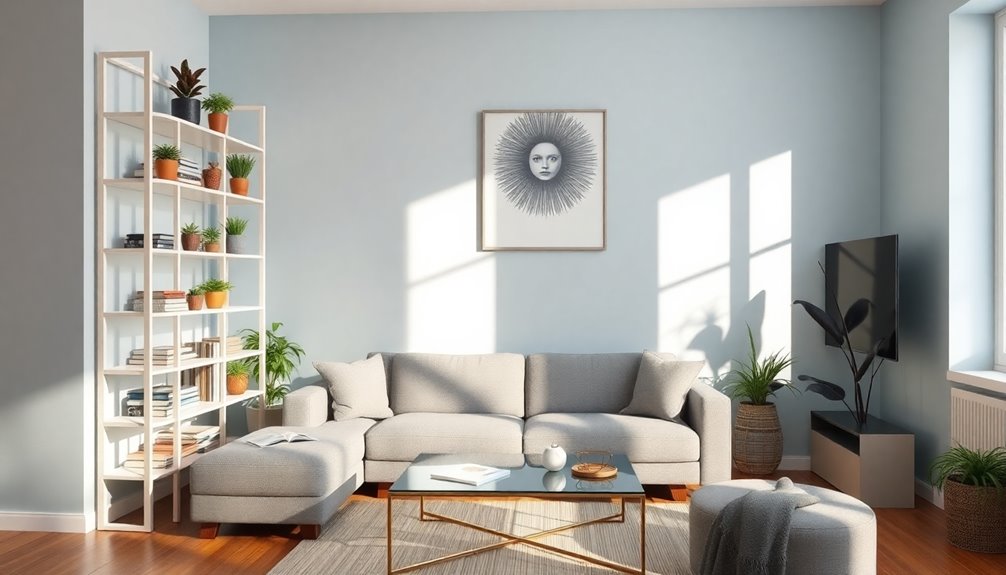
Maximizing vertical space is essential in small rooms, and there are several smart strategies to achieve this.
Start by incorporating tall shelving units or bookcases to draw the eye upward, providing ample storage and display options.
Hang draperies closer to the ceiling to create the illusion of taller walls, making the room feel more expansive.
Utilize wall-mounted shelves and pegboards for creative organization and decoration while freeing up valuable floor space.
Choose tall furniture pieces like cabinets or armoires to utilize vertical dimensions without overcrowding the room.
Finally, incorporate vertical design elements, such as striking artwork or wall-mounted plants, to enhance height perception and add visual interest to your cozy space.
Take Advantage of Natural Light
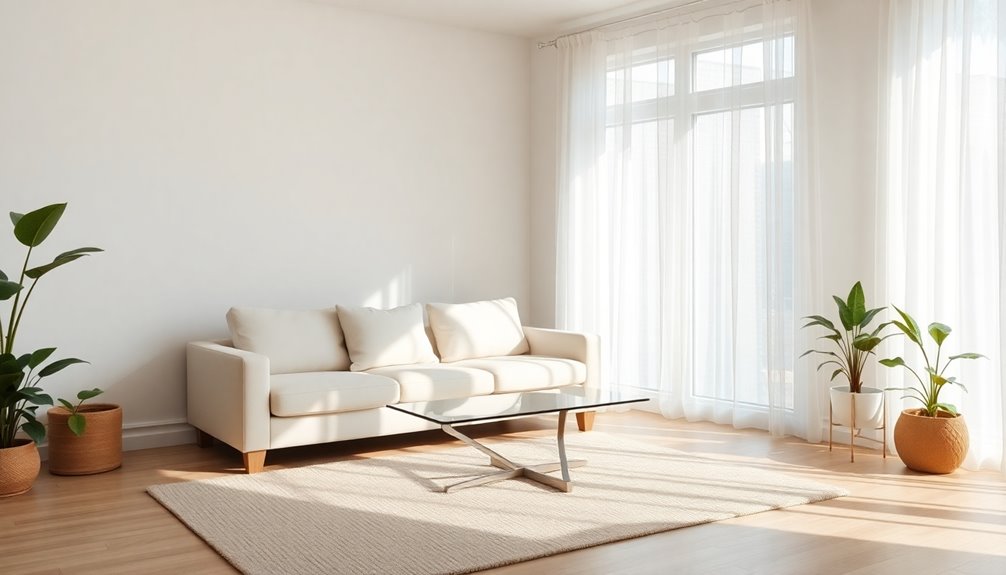
To make the most of natural light in your small space, position your furniture near windows.
Sheer window treatments can help filter light while still offering privacy, creating a bright and airy atmosphere.
Maximize Window Placement
How can you make the most of natural light in a small space? Maximizing window placement is key to creating an airy atmosphere. Here are some effective strategies:
- Position furniture near windows to enhance the connection to natural light.
- Use light-colored furnishings to amplify the perception of space.
- Incorporate reflective surfaces, like mirrors, to bounce light around the room.
- Arrange your seating area to face windows, fostering warmth and conversation.
Use Sheer Treatments
While you want to make the most of natural light in a small space, using sheer window treatments can be a game-changer.
Sheer curtains allow sunlight to filter in, creating an airy atmosphere that instantly makes your small living room feel larger. You'll maintain privacy while embracing the warmth and brightness natural light brings. This can enhance the visual appeal of your light-colored furniture, promoting a cohesive decor style.
Plus, sheer treatments soften stark walls, adding warmth to your overall design. By allowing sunlight to warm the room during the day, you can also reduce energy costs, decreasing your reliance on artificial lighting.
Opt for Multi-Functional Furniture
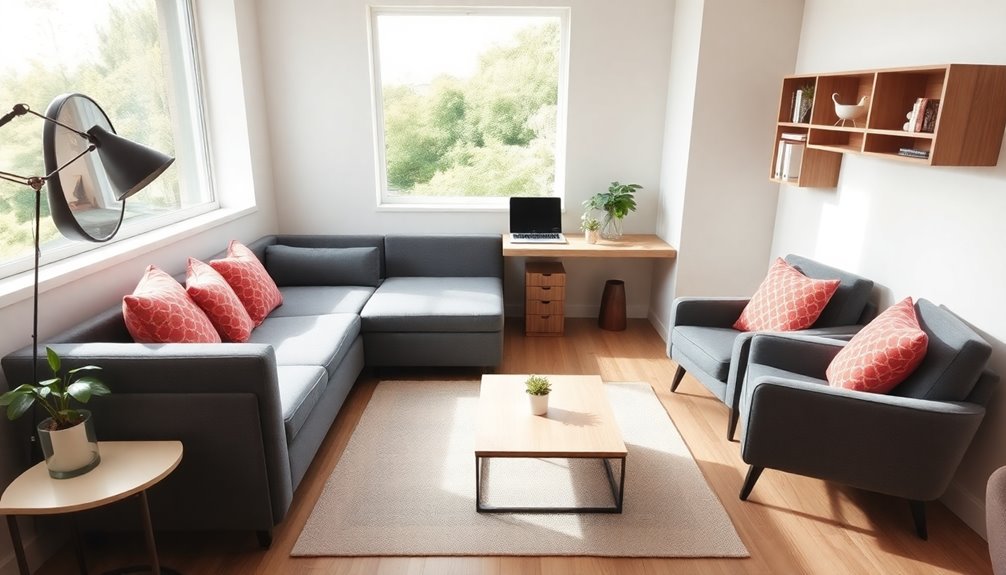
When you live in a small space, opting for multi-functional furniture can greatly enhance your living experience.
These versatile pieces maximize utility, reduce clutter, and create a streamlined aesthetic. Consider the following options:
- Convertible furniture like sofa beds for guests
- Storage solutions such as benches with compartments
- Nesting tables that allow for adaptable layouts
- Lightweight chairs for easy rearrangement
With multi-functional designs, you gain flexibility in compact areas, making it easy to entertain or relax. Additionally, incorporating natural materials in your furniture can enhance the overall warmth and charm of your space.
By incorporating these items, you not only optimize your space but also create an inviting atmosphere.
Say goodbye to clutter and enjoy a more functional living environment that meets all your needs!
Utilize Area Rugs
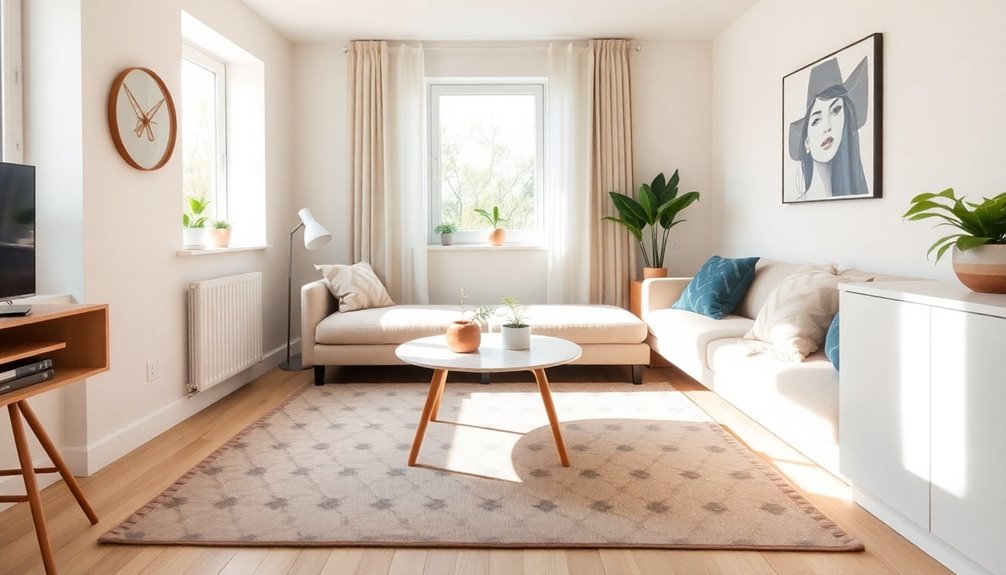
Utilizing area rugs can dramatically transform your small space by defining distinct zones for various activities.
In a small living space, choosing the right area rugs can visually separate lounging from dining areas without physical barriers. Opt for rugs that allow at least the front legs of your sofas and chairs to rest on them; this helps to complement furniture arrangements.
Consider layering rugs for added depth and texture, enhancing visual interest without overwhelming the room. Light-colored or neutral area rugs can maintain an airy feel, making your space appear larger.
Additionally, textured options like woven or plush rugs can provide a cozy atmosphere underfoot, making your small living area feel warm and inviting.
Furnish Open-Concept Living Rooms Sparingly
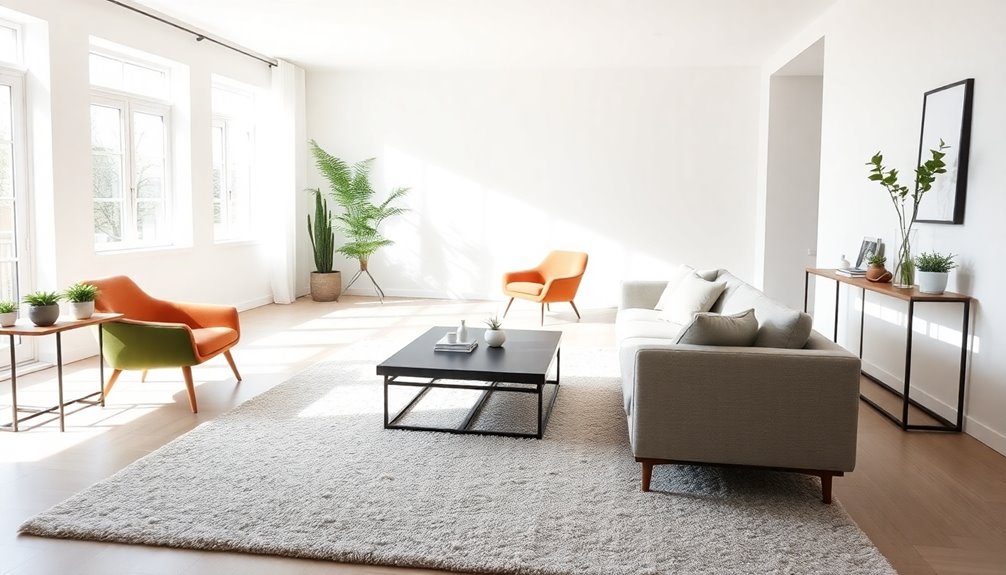
To create a welcoming atmosphere in an open-concept living room, it's essential to furnish the space sparingly. Overcrowding can make your area feel cramped and less inviting.
By selecting a few large pieces, you maintain a cozy atmosphere while enhancing the visual effect. Here are some tips:
- Choose a statement sofa and a coffee table to keep things simple.
- Use area rugs to define the living space without physical walls.
- Aim for balanced furnishings to promote an open flow.
- Incorporate versatile furniture, like convertible sofas or nesting tables, for added functionality.
This streamlined design encourages movement and interaction among family and guests, making your open-concept living room both inviting and practical.
Frequently Asked Questions
What Is the 2/3 Rule Furniture?
The 2/3 rule in furniture design suggests that the height of your furniture should be about two-thirds the height of your walls.
This guideline helps create a balanced visual proportion, making your space feel more cohesive and less cluttered.
For instance, in an 8-foot room, aim for furniture between 5 and 6.5 feet tall.
What Type of Furniture Do You Choose When Decorating a Small Room?
When decorating a small room, you might think that any furniture can fit, but that's not true.
You should choose small-scale pieces that create an open feel, like sleek armchairs instead of bulky sofas.
Opt for multi-functional items, such as ottomans with storage, to maximize utility.
Light-colored furniture and those with legs help enhance space perception.
Finally, consider modular options like sofa beds for flexibility, adapting to your needs effortlessly.
What Are the Four Rules in Furniture Arrangement?
When arranging furniture, you should follow four key rules for a successful layout.
First, focus on your room's focal point, orienting furniture around it.
Next, guarantee clear traffic flow by positioning pieces to allow easy movement.
Third, use furniture to define areas within the space.
Finally, choose appropriately scaled items that won't overwhelm the room.
What Is the Biggest Mistake in Placement of Furniture?
The biggest mistake in furniture placement is pushing all your pieces against the walls. This can make your space feel disconnected and cramped instead of warm and inviting.
You'll want to create defined zones within your room to enhance functionality. Also, remember to take into account traffic flow; it's essential for a comfortable layout.
Finally, avoid overcrowding with oversized furniture, as that can overwhelm the area and hinder your room's overall aesthetic.
Conclusion
In the grand tapestry of tiny living, your furniture layout can transform a cramped cave into a cozy palace! By embracing focal points and multi-functional pieces, you're not just maximizing space; you're orchestrating a symphony of style and comfort! Pulling furniture away from walls and inviting natural light can make your small space feel like a sunlit sanctuary. So go ahead, sprinkle in some clever arrangements, and watch your small space bloom into a stunning oasis of design!
